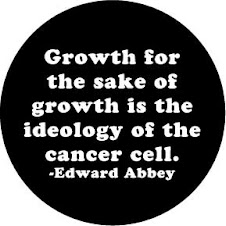“That all people should have free access to air and water of acceptable quality is a fundamental human right.” (WHO 2000)
I’d like to spend several posts examining water to start with.
Clean fresh water is the most precious of resources. Second only to fresh air to breath.
Overview of current global water situation
Worldwide use of freshwater has grown at the twice the population rate of increase in the last 100 years. 1.8 billion people will be living in a condition of absolute water scarcity by 2025. For most of the world, agriculture is both the largest and most important consumer of water accounting for 70% of all water use globally. (UN Water Thematic Initiatives 2006)
“It is suggested that an additional 5,600 km3/yr of consumptive water use will be needed to produce an adequate amount of food by 2050 - i.e. almost a doubling of today’s consumptive use of 6800 km3/yr........Expanded irrigation can only solve part of the problem. Already today, there is a large scale overappropriation of river flow over 15% of the land area (Smathkin et al., 2004). In addition there is a huge overuse of groundwater beyond renewable rate......The present irrigation system is.......not sustainable.” (Falkenmark 2006)
Fully one quarter of groundwater withdrawal is not sustainable according to The Millenium Ecosystem Assessment. While 1.1 billion of the world’s people lack access to improved water supplies, 2.6 billion lack access to to improved sanitation. (UN World Water Assessment Program 2006)
“Irrigation agriculture, responsible for nearly 40% of world food production, uses about 70% of total water withdrawals.” (United Nations Economic and Social Council 1997)
In the next 30 years approximately 14% more freshwater will be needed by agriculture just to keep pace with the growing demand for food. (UN Water Thematic Initiatives 2006)
Water pollution
We are not only using too much water but we’re abusing it as well. The most common contaminants found in water, after salt, are agricultural chemicals. Just looking at one of the primary staple food crops, corn, is instructive. Corn production in the US involves vast quantities of commercial nitrogen, applied to 98% of corn fields, and commercial phospate, applied to 87% of corn fields.(USDA Economic Research Service 2002) That’s 91.73 million acres or approximately 1.5 times the entire land mass of the UK sprayed with commercial nitrogen in 2007 if the rate remained the same. Both those chemicals are eutrophying agents. They stimulate the growth of microorganisms which use up all the oxygen in the water and thus everything else either leaves, if it can, or dies. The Gulf of Mexico has a large and growing deadzone, currently 6600 square miles in size, largely a result of corporate agricultural and industrial practices resulting in polluted runoff into the Mississippi river. (Food and Water Watch 2007)
Also widely used on the the US corn crop, is atrazine, one of the most widely used herbicides on earth, a known carcinogen and banned in the EU.
“The EPA acknowledges that ‘there is significant, widespread exposure to atrazine and it’s metabolites in drinking water’ and warns that exposure to atrazine can cause ‘congestion of the heart, lungs and kidneys;low blood pressure;muscle spasms;weight loss, and damage to adrenal glands....... cardiovascular damage, retinal and some muscle degeneration and cancer’” (US EPA 2006)
The EPA under the Clinton administration found that 43% of the 1million lbs/yr of chemicals produced or imported in the US have no basic toxicity data with only 7% having undergone full basic toxicity testing. One such chemical, perchlorate, a chemical used in the defense industry is showing up in groundwater.
“About 20 million Americans have rocket fuel ingredient perchlorate present as a contaminant in their tap water. No safe level has been established for the chemical which can disrupt thyroid function and cause cancer.” (WWF Freshwater Program 2006)
This is scary stuff and I’ll pause here. Next post I’ll talk about virtual water which begins to tie in water use with sustainable living.
What have you done today to lower your impact?
We are washing away the foundations of our existence on every front. It is high time we move from crashing about on the planet like a bull in china shop and find a way to go forward with intent. We must find systems of living based on sustainability. The systems and tools exist, it is up to each of us to adopt them.
Blog Archive
-
▼
2008
(188)
-
▼
February
(22)
- Video - Vesco Back from Exhaustion Part 4
- Video - Vesco Back from Exhaustion Part Two
- Food part 1 - Soil erosion - by Robb
- Video - Vesco Back from Exhaustion Part 1
- The Epiphany of Enough by Dave
- Research tidbit - Lake Mead
- Corn ethanol and Water in the US Part 5 - by Robb
- Video - Joanna Macy on The Great Turning
- The Eighth Deadly Sin by Dave
- Corn ethanol and Water in the US Part 4 - by Robb
- Corn ethanol and Water in the US Part 3 - by Robb
- Corn ethanol and Water in the US Part 2 - by Robb
- Welcome Dave; another author - by Robb
- video - Affordable Green Housing
- Corn ethanol and Water in the US Part 1 - by Robb
- Virtual Water - by Robb
- Yikes
- What's truly needed? some details - by Robb
- video - Worth Watching
- Personal Health and Basic Needs - by Robb
- Why Sustainable living? The Golden Rule - by Robb
- Sustainable living; my definition - by Robb
-
▼
February
(22)
Subscribe to:
Post Comments (Atom)




.jpg)







No comments:
Post a Comment